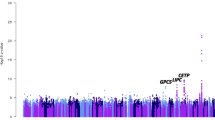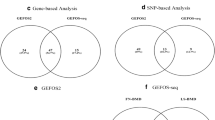Abstract
Genome-wide association studies (GWAS) have successfully identified numerous genetic variants associated with diverse complex phenotypes and diseases, and provided tremendous opportunities for further analyses using summary association statistics. Recently, Pickrell et al. developed a robust method for causal inference using independent putative causal SNPs. However, this method may fail to infer the causal relationship between two phenotypes when only a limited number of independent putative causal SNPs identified. Here, we extended Pickrell’s method to make it more applicable for the general situations. We extended the causal inference method by replacing the putative causal SNPs with the lead SNPs (the set of the most significant SNPs in each independent locus) and tested the performance of our extended method using both simulation and empirical data. Simulations suggested that when the same number of genetic variants is used, our extended method had similar distribution of test statistic under the null model as well as comparable power under the causal model compared with the original method by Pickrell et al. But in practice, our extended method would generally be more powerful because the number of independent lead SNPs was often larger than the number of independent putative causal SNPs. And including more SNPs, on the other hand, would not cause more false positives. By applying our extended method to summary statistics from GWAS for blood metabolites and femoral neck bone mineral density (FN-BMD), we successfully identified ten blood metabolites that may causally influence FN-BMD. We extended a causal inference method for inferring putative causal relationship between two phenotypes using summary statistics from GWAS, and identified a number of potential causal metabolites for FN-BMD, which may provide novel insights into the pathophysiological mechanisms underlying osteoporosis.




Similar content being viewed by others
References
Benjamini YH, Hochberg Y (1995) The false discovery rate—a practical and powerful approach to multiple testing. J R Stat Soc, Ser B 57(1):289–300
Berisa T, Pickrell JK (2016) Approximately independent linkage disequilibrium blocks in human populations. Bioinformatics 32:283–285. https://doi.org/10.1093/bioinformatics/btv546
Bonucci E (2012) Bone mineralization. Front Biosci (Landmark Ed) 17:100–128
Brion MJ, Shakhbazov K, Visscher PM (2013) Calculating statistical power in Mendelian randomization studies. Int J Epidemiol 42:1497–1501. https://doi.org/10.1093/ije/dyt179
Bulik-Sullivan B, Finucane HK, Anttila V, Gusev A, Day FR, Loh PR et al (2015) An atlas of genetic correlations across human diseases and traits. Nat Genet 47:1236–1241. https://doi.org/10.1038/ng.3406
Burgess S, Dudbridge F, Thompson SG (2016) Combining information on multiple instrumental variables in Mendelian randomization: comparison of allele score and summarized data methods. Stat Med 35:1880–1906. https://doi.org/10.1002/sim.6835
Cartwright N (2009) What are randomised controlled trials good for? Philos Stud 147:59–70. https://doi.org/10.1007/s11098-009-9450-2
Chalmers TC, Smith H Jr, Blackburn B, Silverman B, Schroeder B, Reitman D et al (1981) A method for assessing the quality of a randomized control trial. Control Clin Trials 2:31–49
Cummings SR, Melton LJ (2002) Epidemiology and outcomes of osteoporotic fractures. Lancet 359(9319):1761–1767
Dalbeth N, Topless R, Flynn T, Cadzow M, Bolland MJ, Merriman TR (2015) Mendelian randomization analysis to examine for a causal effect of urate on bone mineral density. J Bone Miner Res 30:985–991. https://doi.org/10.1002/jbmr.2434
Davey Smith G, Hemani G (2014) Mendelian randomization: genetic anchors for causal inference in epidemiological studies. Hum Mol Genet 23:R89–R98. https://doi.org/10.1093/hmg/ddu328
Dettmer KAP, Hammock BD (2007) Mass spectrometry-based metabolomics. Mass Spectrom. Mass Spectrom Rev 26(1):51–78
Ference BA, Yoo W, Alesh I, Mahajan N, Mahajan N, Mirowska KK, Mewada A, Kahn J et al (2012) Effect of long-term exposure to lower low-density lipoprotein cholesterol beginning early in life on the risk of coronary heart disease: a Mendelian randomization analysis. J Am Coll Cardiol 60(25):2631–2639
Freeman G, Cowling BJ, Schooling CM (2013) Power and sample size calculations for Mendelian randomization studies using one genetic instrument. Int J Epidemiol 42:1157–1163. https://doi.org/10.1093/ije/dyt110
Global Lipids Genetics C (2013) Discovery and refinement of loci associated with lipid levels. Nat Genet 45:1274–1283. https://doi.org/10.1038/ng.2797
Harvey N, Dennison E, Cooper C (2010) Osteoporosis: impact on health and economics. Nat Rev Rheumatol 6(2):99–105
Hemani G, Tilling K, Davey Smith G (2017) Orienting the causal relationship between imprecisely measured traits using GWAS summary data. PLoS Genet 13:e1007081. https://doi.org/10.1371/journal.pgen.1007081
Illig T, Gieger C, Zhai G, Romisch-Margl W, Wang-Sattler R, Prehn C et al (2010) A genome-wide perspective of genetic variation in human metabolism. Nat Genet 42:137–141. https://doi.org/10.1038/ng.507
Kettunen J, Tukiainen T, Sarin AP, Ortega-Alonso A, Tikkanen E (2012) Genome-wide association study identifies multiple loci influencing human serum metabolite levels. Nat Genet 44:269–276. https://doi.org/10.1038/ng.1073
Kolz M, Johnson T, Sanna S, Teumer A, Vitart V, Perola M et al (2009) Meta-analysis of 28,141 individuals identifies common variants within five new loci that influence uric acid concentrations. PLoS Genet 5:e1000504. https://doi.org/10.1371/journal.pgen.1000504
Lin SYCY (2000) Simultaneous formation and detection of the reaction product of solid-state aspartame sweetener by FT-IRDSC microscopic system. Food Addit Contam 17(10):821–827
Lv H, Jiang F, Guan D, Lu C, Guo B, Chan C et al (2016) Metabolomics and its application in the development of discovering biomarkers for osteoporosis research. Int J Mol Sci. https://doi.org/10.3390/ijms17122018
Maggio D, Barabani M, Pierandrei M, Polidori MC, Catani M, Mecocci P et al (2003) Marked decrease in plasma antioxidants in aged osteoporotic women: results of a cross-sectional study. J Clin Endocrinol Metab 88:1523–1527. https://doi.org/10.1210/jc.2002-021496
Manion CV, Hochgeschwender U, Edmundson AB, Hugli TE, Gabaglia CR (2011) Dietary aspartyl-phenylalanine-1-methyl ester delays osteoarthritis and prevents associated bone loss in STR/ORT mice. Rheumatology (Oxford) 50:1244–1249. https://doi.org/10.1093/rheumatology/ker089
Mokry LE, Ross S, Ahmad OS, Forgetta V, Smith GD, Goltzman D et al (2015) Vitamin D and risk of multiple sclerosis: a mendelian randomization study. PLoS Med 12:e1001866. https://doi.org/10.1371/journal.pmed.1001866
O’Connor LJ, Price AL (2017) Distinguishing genetic correlation from causation across 52 diseases and complex traits. bioRxiv. https://doi.org/10.1101/205435
Palermo A, Tuccinardi D, D’Onofrio L, Watanabe M, Maggi D, Maurizi AR et al (2017) Vitamin K and osteoporosis: myth or reality? Metabolism 70:57–71. https://doi.org/10.1016/j.metabol.2017.01.032
Peterkofsky B, Gosiewska A, Kipp DE, Shah V, Wilson S (1994) Circulating insulin-like growth factor binding proteins (IGFBPs) 1 and 2 induced in vitamin C-deficient or fasted guinea pigs inhibit IGF-I action in cultured cells. Growth Factors 10(4):229–241
Pickrell JK, Berisa T, Liu JZ, Segurel L, Tung JY, Hinds DA (2016) Detection and interpretation of shared genetic influences on 42 human traits. Nat Genet 48:709–717. https://doi.org/10.1038/ng.3570
Schunkert H, Konig IR, Kathiresan S, Reilly MP, Assimes TL, Holm H et al (2011) Large-scale association analysis identifies 13 new susceptibility loci for coronary artery disease. Nat Genet 43:333–338. https://doi.org/10.1038/ng.784
Shin SY, Fauman EB, Petersen AK, Krumsiek J (2014) An atlas of genetic influences on human blood metabolites. Nat Genet 46:543–550. https://doi.org/10.1038/ng.2982
Smilde AK, Westerhuis JA, Hoefsloot HCJ, Bijlsma S, Rubingh CM, Vis DJ, Jellema RH et al (2010) Dynamic metabolomic data analysis: a tutorial review. Metabolomics 6(1):3–17
Sugiura M, Nakamura M, Ogawa K, Ikoma Y, Ando F, Shimokata H, Yano M et al (2011) Dietary patterns of antioxidant vitamin and carotenoid intake associated with bone mineral density: findings from post-menopausal Japanese female subjects. Osteoporos Int 22(1):143–152
Verbanck M, Chen C-Y, Neale B, Do R (2017) Widespread pleiotropy confounds causal relationships between complex traits and diseases inferred from Mendelian randomization. bioRxiv. https://doi.org/10.1101/157552
Vimaleswaran KS, Berry DJ, Lu C, Tikkanen E, Pilz S, Hiraki LT et al (2013) Causal relationship between obesity and vitamin D status: bi-directional Mendelian randomization analysis of multiple cohorts. PLoS Med 10:e1001383. https://doi.org/10.1371/journal.pmed.1001383
Welsh P, Polisecki E, Robertson M, Jahn S, Buckley BM, de Craen AJ et al (2010) Unraveling the directional link between adiposity and inflammation: a bidirectional Mendelian randomization approach. J Clin Endocrinol Metab 95:93–99. https://doi.org/10.1210/jc.2009-1064
Wilson ID, Plumb R, Granger J, Major H, Williams R, Lenz EM (2005) HPLC-MS-based methods for the study of metabonomics. J Chromatogr B Analyt Technol Biomed Life Sci 817(1):67–76
Zheng HF, Forgetta V, Hsu YH, Estrada K, Rosello-Diez A, Leo PJ et al (2015) Whole-genome sequencing identifies EN1 as a determinant of bone density and fracture. Nature 526:112–117. https://doi.org/10.1038/nature14878
Zhu Z, Zhang F, Hu H, Bakshi A, Robinson MR, Powell JE et al (2016) Integration of summary data from GWAS and eQTL studies predicts complex trait gene targets. Nat Genet 48:481–487. https://doi.org/10.1038/ng.3538
Zhu Z, Zheng Z, Zhang F, Wu Y, Trzaskowski M, Maier R, et al. (2017) Causal associations between risk factors and common diseases inferred from GWAS summary data. boiRxiv. https://doi.org/10.1101/168674
Ziegler A, Mwambi H, Konig IR (2015) Mendelian randomization versus path models: making causal inferences in genetic epidemiology. Hum Hered 79:194–204. https://doi.org/10.1159/000381338
Acknowledgements
We thank all the study subjects for volunteering to participate in the study. We thank Genetic Factors for Osteoporosis Consortium provided the BMD replication dataset to download for us. Also, we thank Shin SY et al. to provide metabolomics GWAS results for download.
Funding
This study was supported in part by Natural Science Foundation of China (NSFC; 81570807, 30900810, 31271344 and 31071097), Hunan Provincial Construct Program of the Key Discipline in Ecology (0713) and the Cooperative Innovation Center of Engineering and New Products for Developmental Biology of Hunan Province (20134486). The investigators of this work were also partially supported by grants from the NIH (R01 AR069055, U19 AG055373, R01 MH104680, R01 AR059781 and P20 GM109036), and the Edward G. Schlieder Endowment as well as the Drs. W. C. Tsai and P. T. Kung Professorship in Biostatistics from Tulane University.
Author information
Authors and Affiliations
Corresponding author
Ethics declarations
Conflict of interest
The authors have no financial interests to disclose.
Electronic supplementary material
Below is the link to the electronic supplementary material.
Rights and permissions
About this article
Cite this article
Meng, XH., Shen, H., Chen, XD. et al. Inferring causal relationships between phenotypes using summary statistics from genome-wide association studies. Hum Genet 137, 247–255 (2018). https://doi.org/10.1007/s00439-018-1876-1
Received:
Accepted:
Published:
Issue Date:
DOI: https://doi.org/10.1007/s00439-018-1876-1




